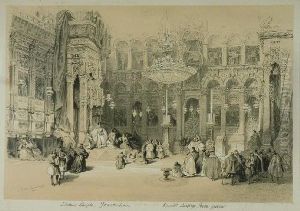Louis-Joseph Ghemar Paintings
Louis-Joseph Ghémar was a notable Belgian photographer and lithographer, born in 1819 in Liège, Belgium, and died in 1873. His career spanned a transformative period in the history of photography and lithography, making significant contributions to the development of photographic techniques and practices in Belgium and beyond. Ghémar initially trained as a lithographer, a field in which he excelled, but his interests and innovative spirit led him to explore the burgeoning field of photography.
After establishing himself as a lithographer, Ghémar shifted his focus to photography, intrigued by its potential for capturing life with a realism unattainable in traditional lithography. He was among the early adopters of photographic processes in Belgium, experimenting with daguerreotypes, ambrotypes, and eventually, albumen prints. Ghémar's work in photography was marked by a keen eye for composition and an ability to capture the essence of his subjects, ranging from portraits to architectural studies.
In the 1850s, Ghémar co-founded the 'Société Royale Belge de Photographie' (Royal Belgian Society of Photography), which played a crucial role in promoting photography as a respected art form in Belgium. His involvement in this society underscored his commitment to advancing photography, both as a technique and as an art. Ghémar's photographic studio in Brussels became a center of innovation and a gathering place for artists, intellectuals, and the Belgian elite, further cementing his status as a pioneer in the field.
Beyond his technical and artistic contributions, Ghémar was also noted for his collaborations with other artists and his efforts to document and preserve Belgian cultural heritage through photography. His portraits of notable figures of his time, including royalty, artists, and politicians, offer a valuable historical record of Belgian society in the mid-19th century.
Louis-Joseph Ghémar's legacy is that of a visionary who bridged the worlds of lithography and photography. His work not only advanced the technical aspects of photography but also elevated it as a form of artistic expression. He left behind a body of work that continues to be celebrated for its artistic quality and historical significance.


